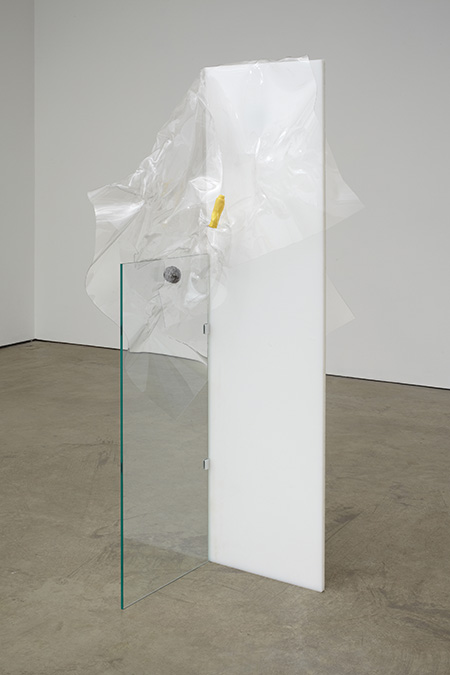Juliette Bonneviot

Let’s start simply: ‘Minimal Jeune Fille’ (Minimal Young Girl) was an exhibition of works by the young French artist Juliette Bonneviot. It was her second exhibition to date at Wilkinson Gallery and the second outing for this project, which was shown at the 12th Biennale de Lyon last autumn. In London, it comprised 14 works, which were sparsely arranged across the downstairs gallery: ten wall-based components, three freestanding sculptures and one video. Having originally studied painting at the École des Beaux-Arts in Paris, Bonneviot’s past works range from a mannequin of a Russian raver based on an online image to a bootleg re-painting of Ed Ruscha’s Things Oriental (1985). By comparison, this installation felt muted: plastic and stainless steel were the predominant materials and the audio-less projection made the sense of silence somehow oppressive.
On the first wall hung seven identical female torsos, moulded out of sheets of clear PET plastic, with ripples that cast molten shadows on the wall behind. Each was inscribed with fragments of advice on how to limit the environmental impact of your life: ‘compost hair and nail clippings’; ‘forget about q-tips, they are not good for you anyways’. The significance of the type of plastic, a recyclable material commonly used for packaging such as water bottles, was indicated by the titles in the series, which included PET Woman. Dining and Entertaining Tips and PET Woman. Bathroom Tips (all works 2013). (In recent years there has been quite a number of works recycling plastic water bottles: from Tue Greenfort’s 2008 Condensation project to Pamela Rosenkranz’s skin-coloured bottle series ‘The Most Important Body of Water is Yours’, 2010). The pun on ‘PET’, as a word and an acronym, likens the women issuing these ecological injunctions to domesticated creatures or assembly-line commodities. The transparent trunk, meanwhile, offered a disturbing image of their ‘zero waste’ fantasy.
Something about the language used in the ‘tips’ suggests that these words were appropriated from online forums, in which housewives share their experiences of incorporating industrial environmental strategies into the home. Taking this community as inspiration, Bonneviot created a narrative for her project in which a housewife is the heroine. The story is fuelled by two further sources: first is the academic Timothy Morton’s concept of ‘dark ecology’, in which he critiques the tendency to place nature on a pedestal in a ‘paradoxical act of sadistic admiration’. The second is the French collective Tiqqun, whose Preliminary Materials for a Theory of the Young-Girl (published in 1999, but only belatedly translated into English in 2012) outlines the ‘model citizen’ as defined by postwar consumer culture. A figure of spectacular consumption (who Bonneviot likens in her ‘Working Notes’ to the college girls in the 2013 film Spring Breakers), the Young-Girl is set by the artist against her ultimate adversary: her own waste.
Minimal Jeune Fille. Mindscape, which was partially projected over the line of torsos, presents a dystopian CGI landscape of concrete cubes, each inhabited by a housewife performing a simple domestic task, with subtitles such as, ‘I must get over my fear of canning.’ The instruments of their obsession feature as materials in the larger sculptures on display, such as Minimal Jeune Fille. Kitchen Worktop, which comprises a wooden board, wooden brush and high-density polyethylene bottle top. These, too, have sad snippets of online exchange scrawled into them: ‘my husband is insistent on putting products in the flimsy plastic bags at grocery stores’ and beneath it, ‘Hi Jeanette! My husband is the same’.
While producing this body of work, Bonneviot followed the lifestyle of her protagonist – a performance that could have been more clearly articulated, either in the gallery text or through the selection of work. Any plastic waste that she could not reduce was recycled into pieces such as Minimal Jeune Fille Trash Tiles, which was shown in Lyon but not London. This is a project of great complexity and I wonder if Bonneviot would have benefitted from an exhibition that was a little less minimal.
















